As you stroll along Florida’s beautiful coastline and beaches, it’s not uncommon to spot a variety of unique and stunning birds. Whether you’re a seasoned birdwatcher or just appreciate the beauty of nature, these six birds are sure to capture your attention with their vibrant colors and distinctive features. From the majestic pelican to the playful seagull, each species brings its own charm and personality to Florida’s coastal ecosystem. So grab your binoculars and get ready for an unforgettable bird-watching experience on Florida’s shores!
1. American Oystercatcher
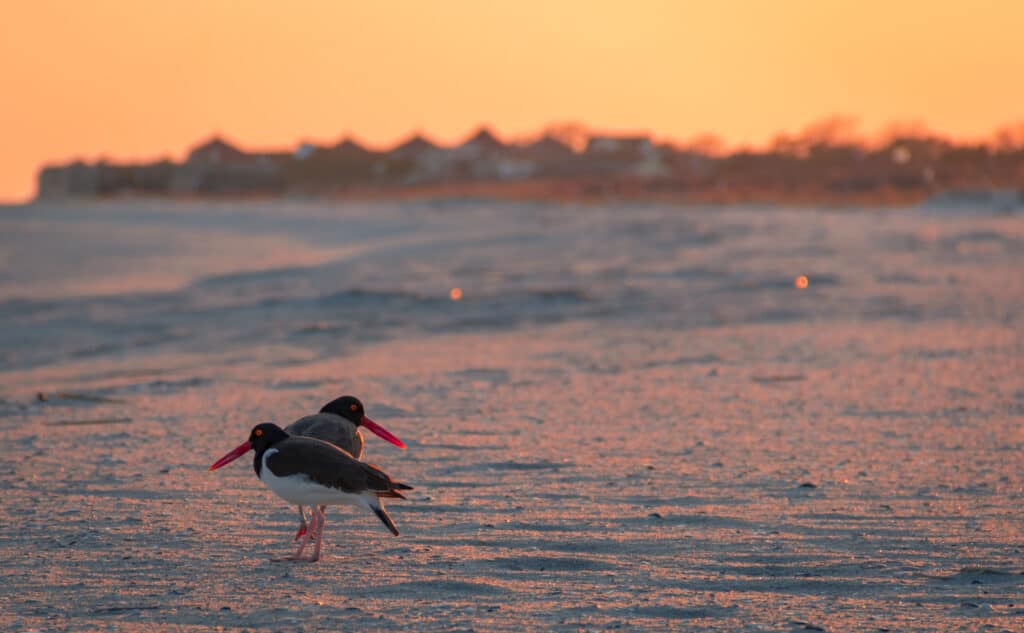
American oystercatchers nest on the ground.
©iStock.com/Rabbitti
The American oystercatcher is an iconic bird species that is commonly found along the coastline and beaches of Florida. These birds are easily recognizable due to their striking black and white plumage, with a distinctive orange beak that adds a pop of color to their appearance.
In terms of habitat, American oystercatchers prefer sandy beaches, rocky shores, and coastal marshes where they can forage for food. They also nest in these areas, creating shallow scrapes in the sand or gravel where they lay their eggs.
When it comes to nesting habits, American oystercatchers are monogamous birds that form pairs during the breeding season. They typically lay two to three eggs per clutch, which both parents take turns incubating until hatching in around 28 days.
As far as diet goes, the American oystercatcher primarily feeds on bivalves such as clams and mussels which they pry open using their powerful bills. They also eat other small marine animals like crabs and worms.
Overall, the American oystercatcher is a fascinating bird species that plays an important role in Florida’s coastal ecosystem. Their unique physical characteristics, combined with interesting nesting habits and dietary preferences, make them one of the most sought-after sightings for bird enthusiasts along Florida’s coastline and beaches.
2. Snowy Plover
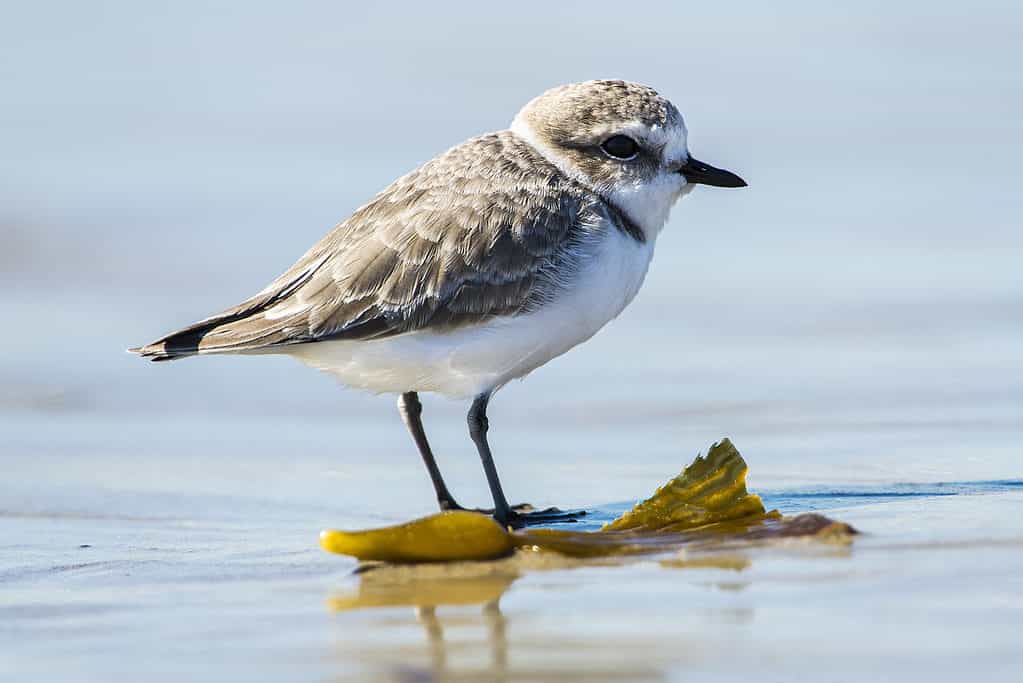
Snowy Plover (Charadrius nivosus) spends the summer in Florida.
©iStock.com/drferry
The snowy plover is a small bird that can be found along the coastline and beaches of Florida. It has a distinctive white forehead, brownish-gray upper parts, and pale underparts. Their habitat consists of sandy beaches, dunes, salt pans, and mudflats near coastal areas. They are commonly seen foraging in pairs or small groups on the beach.
Snowy plovers typically nest on open sand spits or flat areas with sparse vegetation above the high tide line. The nest is usually just a shallow scrape in the ground lined with bits of shell or debris from the surrounding area. These birds have unique nesting habits as they often lay their eggs directly on the sandy substrate without any material to build nests.
Their diet mainly consists of insects such as flies, beetles, ants, spiders, and marine crustaceans like sand crabs and amphipods, which they pick from the sand surface while foraging along the coastlines.
Due to habitat loss caused by human activities such as coastal development and recreational use of beaches (off-leash dogs etc.), these birds are listed amongst “endangered” species by US federal agencies like Fish & Wildlife Service, highlighting how important it is for us to protect our beautiful wildlife whilst enjoying all that our coastlines have to offer!
3. Ruddy Turnstones
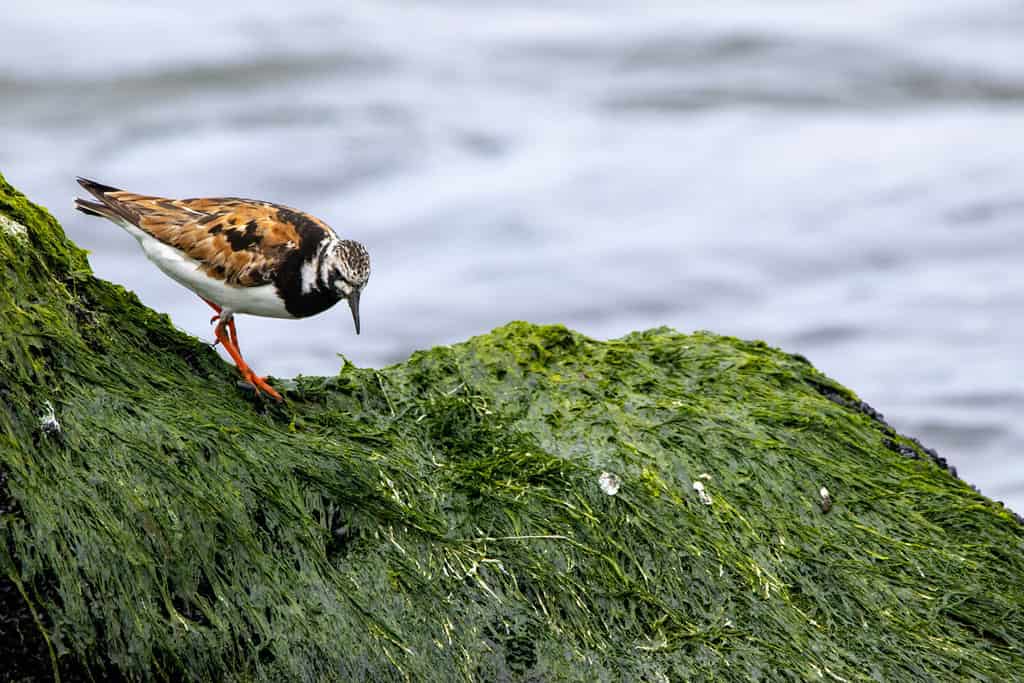
Ruddy turnstones have a mottled brown and white colored plumage.
©CEW/Shutterstock.com
The ruddy turnstone is a small shorebird that can be found along Florida’s coastline and beaches. These birds have a distinctive appearance with mottled brown and white feathers, a short black bill, and bright orange legs. They are about 9 inches in length and weigh around 3 ounces.
Ruddy turnstones prefer rocky or sandy areas near the water’s edge as their habitat. They are often seen probing through seaweed or other debris, looking for food such as insects, crustaceans, mollusks, and marine worms. These birds are also known for flipping over stones to uncover hidden prey.
When it comes to nesting habits, ruddy turnstones typically breed in the Arctic tundra during the summer months before migrating southward towards warmer climates like Florida during winter. Their nests consist of simple scrapes on the ground lined with bits of vegetation or pebbles.
Overall, these fascinating little birds play an important role in maintaining healthy coastal ecosystems by consuming small organisms that may otherwise cause imbalances within marine environments.
4. Brown Pelican
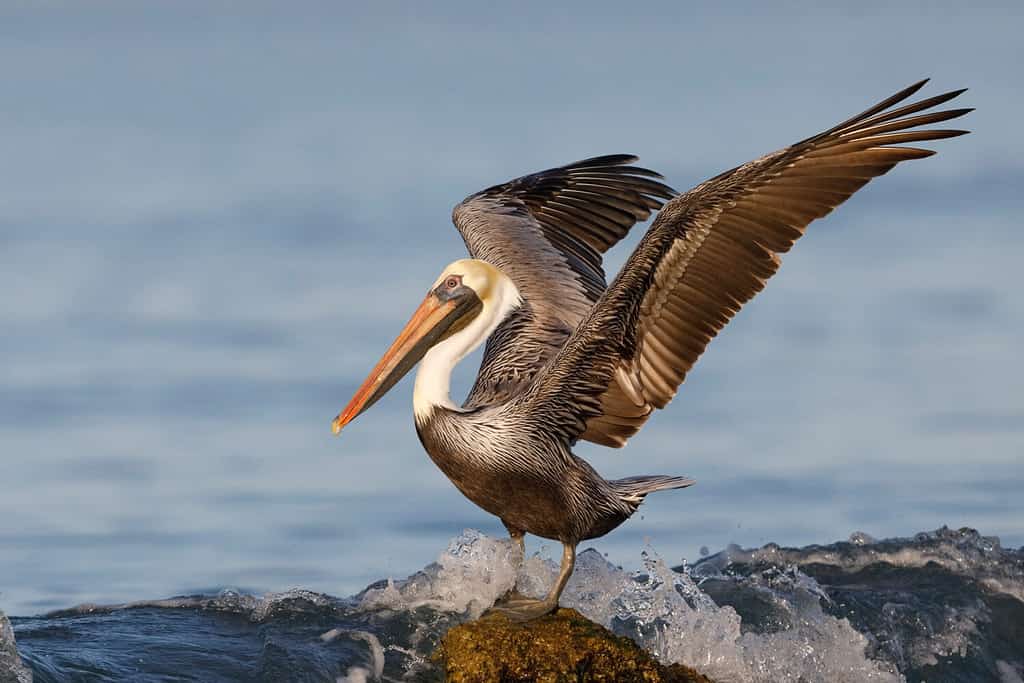
Pelicans eat almost exclusively fish.
©Brian Lasenby/Shutterstock.com
The brown pelican is a beautiful bird that can be found along Florida’s coastline and beaches. These birds are easy to spot due to their striking appearance, which includes a long bill with a pouch, gray-brown feathers on their body, and white or yellowish head and neck.
In terms of habitat, brown pelicans prefer coastal areas such as bays, estuaries, mangroves, and other wetland habitats. They also nest in large colonies on islands or secluded parts of the mainland during the breeding season.
Brown pelicans have unique nesting habits where they build nests made up of sticks and debris on the ground or in trees near water bodies. During mating season, males attract females by performing courtship displays, including flying in circles around potential mates while calling out loudly.
When it comes to diet, these birds feed mainly on fish but also consume things like crayfish and shrimp. Their distinctive pouch helps them catch fish underwater by scooping them up quickly before squeezing out any excess water. Brown Pelicans are known for diving from heights into the ocean at high speeds to catch fish.
Despite being a common sight along Florida’s coastline and beaches, the brown pelican is not immune to threats. One of the biggest dangers facing these birds is human activity, particularly habitat loss due to development and pollution. As coastal areas become increasingly urbanized, nesting sites for brown pelicans are destroyed or disturbed, making it difficult for them to breed successfully.
Additionally, brown pelicans often fall victim to entanglement in fishing gear such as nets and lines. These accidents can cause serious injury or death if the bird becomes trapped underwater or unable to fly. Ingestion of plastic debris also poses a threat to brown pelicans as it can lead to intestinal blockages and other health issues.
Finally, climate change may have long-term impacts on brown pelican populations by altering sea levels and ocean temperatures that affect their food sources. As fish stocks decline or shift locations due to changing environmental conditions, the ability of these birds to find enough food could be compromised.
Overall, while the brown pelican remains a resilient species with stable populations in many areas thanks in part to conservation efforts like those implemented under the Endangered Species Act in the 1970s-80s, ongoing vigilance will be necessary going forward given its vulnerability against numerous threats from both natural forces and man-made activities alik
5. Blue Heron
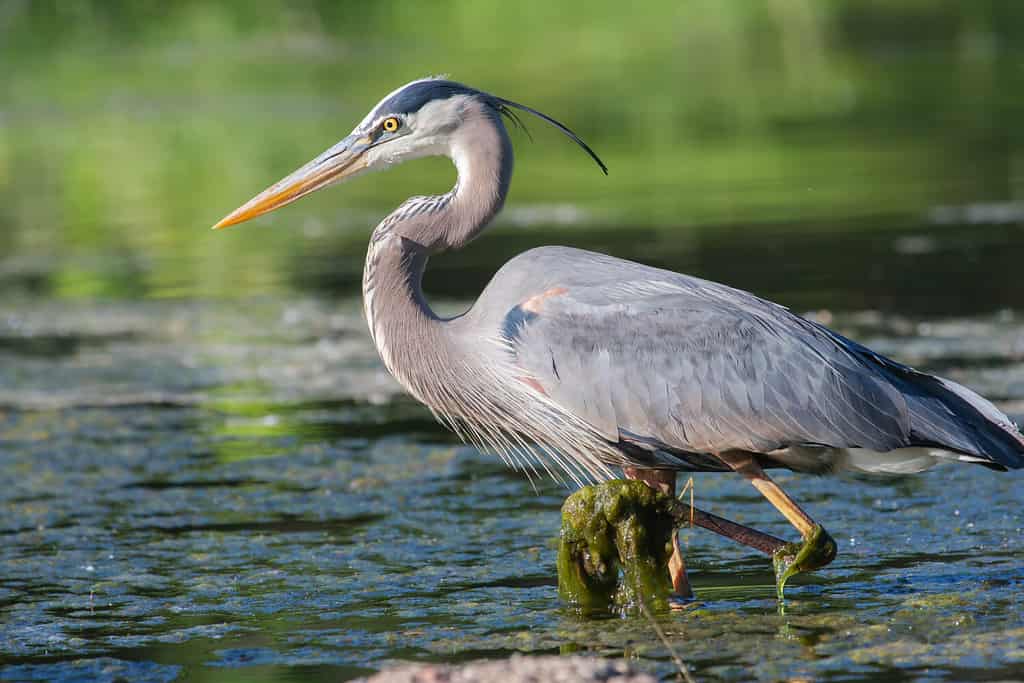
Blue herons can have a wingspan of six feet!
©Joseph Scott Photography/Shutterstock.com
The blue heron is a majestic bird that can be found along the coastline and beaches of Florida. These birds are easily recognizable by their striking blue-gray plumage, long legs, and sharp bills. They have a wingspan of up to 6 feet and can stand up to 4 feet tall.
Blue herons typically inhabit wetlands such as marshes, swamps, or estuaries, where they hunt for fish, amphibians, reptiles, small mammals, and insects using their lightning-fast reflexes. They have been known to wait patiently in shallow waters for hours at a time before striking with deadly accuracy.
During the breeding season between December and July, these impressive birds build large stick nests in trees or shrubs near water sources like lakes or rivers. The female lays two to six pale-blue eggs which both parents take turns incubating for around 28 days until they hatch into fluffy chicks.
Overall, the blue heron is an iconic bird species that plays an important role in keeping Florida’s ecosystems balanced through its predatory behavior. It is truly a sight to behold when you spot one soaring gracefully overhead or perched on the shoreline waiting for its next meal!
6. Laughing Gulls

Laughing gulls have dark-colored beaks, legs, and feet.
©Joerg-Drescher/Shutterstock.com
The laughing gull, also known as the black-headed gull, is a medium-sized bird that measures approximately 16-17 inches in length and has a wingspan of about 40 inches. Their plumage is predominantly gray, with black on their heads during the breeding season and white spots on their wings. They have long bills that are slightly curved downwards.
Laughing gulls can be found along the coastlines and beaches of Florida throughout the year. During winter months, they migrate south to Central America and northern South America. These birds prefer nesting in flat sandy areas near water sources such as lagoons, bays, or estuaries.
During the breeding season, which occurs from April to August in Florida, adult laughing gulls form colonies where they build nests made out of grasses and other vegetation close to one another for protection against predators. The female will lay two to four eggs which both parents take turns incubating for around three weeks until hatching.
These omnivorous birds feed mostly on small fish such as minnows or anchovies but will also eat insects, crustaceans like shrimp or crabs, mollusks including snails or clams, as well as fruits.
In conclusion, if you happen upon a colony of Laughing Gulls along Florida’s coastline or beaches, it’s worth taking some time to watch these fascinating creatures go about their daily lives!
Summary of 6 Birds Along Florida’s Coastline and Beaches
| Number | Bird |
|---|---|
| 1 | American Oystercatcher |
| 2 | Snowy Plover |
| 3 | Ruddy Turnstones |
| 4 | Brown Pelican |
| 5 | Blue Heron |
| 6 | Laughing Gull |
The photo featured at the top of this post is © Nagel Photography/Shutterstock.com
Thank you for reading! Have some feedback for us? Contact the AZ Animals editorial team.







